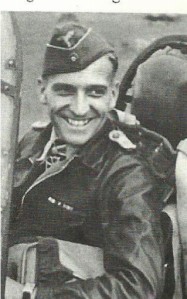Military Heritage Magazine July 2015
Stuka Ace Hans Ulrich Rudel
The Reich’s highest decorated Serviceman
By Ludwig Heinrich Dyck

“I have often looked him [death] in the eye…and have never been the first to lower my gaze,”1 Ulrich Rudel
“In the village of Seiferdau, southern Prussia, an eight-year-old boy with an umbrella jumped out of a second story window. The umbrella turned inside out, the boy landed in a flowerbed and broke his leg. That little boy was Hans Ulrich Rudel, who dreamed of becoming an airman.”
Rudel would go on to become the highest decorated serviceman of the Third Reich, flying an unmatched 2530 combat missions. Field Marshall Ferdinand Schörner did not exaggerate all that much when he praised Rudel as being “worth an entire division.” With his loyal rear gunner protecting his back, Rudel destroyed 547 tanks, 2000 ground targets, the Soviet Battleship Marat, two cruisers and a destroyer. Stalin put a 100,000 ruble ransom on Rudel’s head but nothing could kill the indomitable German Stuka Ace. Shot down 30 times by flak, never by an enemy plane, Rudel risked his own life six times to rescue downed comrades.
Rudel’s sober milk-drinking habits initially ostracized him from the hard-partying pilot culture. It did not help either that he started out as only an average pilot:
“During the Balkan campaign, Rudel, by then an Oberleutnant, was stuck at Reserve Flight in Graz when aerial brilliance came upon him. Rudel’s Stuka stayed attached to his wing leader “like an invisible rope,” hardly every shot wide at bombing or missed at gunnery.”
Rudel’s Immelman Wing joined the siege of Leningrad where they attacked the Soviet Battleship the Marat:
“Absorbed with hitting his target, Rudel released his new 2000-pound bomb at 900 feet, forgetting that its fragmentation effect ranged up to 3,000 feet. Rudel momentarily blacked out, skimming 10 feet above the water. Rear gunner Alfred Scharnovski woke him up: “She is blowing up, sir.”
“In July 1943 the Stukas released a storm of destruction at the Battle of Kursk. Swooping in at 15 to 30 feet above the ground, Rudel’s cannons blasted tungsten-core shells through the thin back armor of enemy tanks. A successful hit entailed flying through an exploding curtain of fire, scorching Rudel’s Stuka and riddling it with splinters.”
“Rudel destroyed 12 of 13 tanks a mere 50 miles from Berlin. With one cannon jammed and a single round remaining in the other, Rudel went for the remaining Stalin tank which “burst into a blaze” when “something seared through” Rudel’s “leg like a strip of red hot steel.””
Rudel earned Germany’s most prestigious combat award, the unique Knight’s Cross with Golden Oak-Leaves, Swords and Diamonds, alongside promotions designed to keep him grounded. Rudel refused both and even disobeyed Hitler if it meant he could no longer fly and aid Germany against the relentless Soviet advance. Even after Rudel lost one of his legs in combat, he kept flying until the end of the war holding to his maxim “he is only lost who gives himself up for lost.”
“Rudel’s noble characteristics are difficult to reconcile with his close association to Hitler’s clique and to far right causes after the war, but Rudel was never accused of any war crime. Indoctrinated in Nazi ideology at an early age, he clung faithfully to what he deemed righteous and either disbelieved or ignored its horrific consequences. Perhaps Douglas Bader, who did not agree with a number of Rudel’s beliefs, summed up Rudel best, concluding that he was “by any standard, a gallant chap.”
Ludwig H. Dyck’s article of the amazing combat career and controversial post-war life of Stuka Ace Hans Ulrich Rudel is featured in the Soldiers column of Military Heritage Magazine’s July 2015 issue.

1Ulrich Rudel, Stuka Pilot (London: Black House Publishing, 2012), p. 54.
